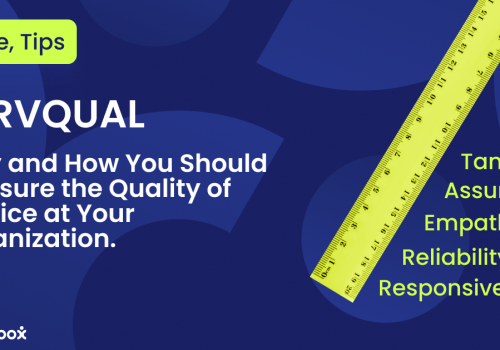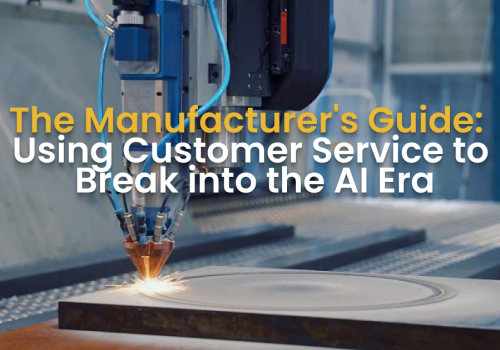Employee Experience. Customer Experience (CX) has become a major focus for businesses recently, and it’s no accident. Getting your CX right has the ability to transform your sales, increase customer loyalty, and take your business to new heights. When customers have great customer experience, they become promoters for your brand. It’s essentially free marketing! There are hundreds of tips and strategies for improving your customer service, but today we’re going to focus on why employee experience should be a top priority when drafting your CX strategy.
Why Employee Experience Matters
Some people argue that employee experience matters more than customer experience. This might be a controversial statement, but once you scratch below the surface it’s easy to understand why some people believe this. Employee experience and customer experience are intrinsically linked.
Many companies are overly focused on short term gains. They want to see high profits, and they want to see them now. This is understandable of course, but when you focus on the short term, you can often lose focus on the long term. When it comes to employees, this can often mean the business will try to maximize the productivity of employees with harsh rules and high targets. This might work in the short term because employees will try hard to meet these targets and will be fearful of punishment.
However, working under high pressure and stress just isn’t sustainable long term. This means you might see an initial spike in productivity when you put the new rules in place, but shortly after, productivity will be worse than it was before. If your targets are so high that the majority of employees can’t keep up with them, then eventually they will stop trying. People are more motivated by positive reinforcement than negative reinforcement. High targets and harsh rules are a form of continual negative reinforcement. Employees will disengage from the process and go into self-protection mode. Self-protection mode might look like this: the employee just does the bare minimum because if they don’t try, then they won’t feel bad when they miss their target. Why does this happen? Because the employee kept missing their target even when they were trying their hardest. If your system punishes employees who try their best, then it is a failed system.
Happy employees are engaged in the workplace. They are happy to be at work and they do good work. When employees are happy and engaged, they treat customers better and will try to go above and beyond for them. This is basic human psychology. When employees feel valued and cared for by the company, they want to invest more of their energy in helping the company succeed. This all happens behind the scenes. It’s unconscious, and it’s not something you can write into the rule book.
Some companies become obsessed with trying to game this system when it can’t be gamed. You can’t tell employees to “work hard for the company” or to “go above and beyond for customers”. If these things are intrinsically linked to customer experience and customer happiness, then just telling your employees to do this is like telling them to be happy. Have you ever told someone to be happy or to cheer up? How successful has that been for you? These kinds of directions don’t work because “happy” is where everyone wants to be, no one is deciding to be unhappy. If it was as easy as just “being happy” then no one would ever feel sad, disengaged, or have low energy.
The same is true for employees. You can’t force employee happiness with a heavy hand and a long list of rules. It has to come organically through the systems you put in place in your company.
Happy Employees Attract Great Talent to The Business
Much like how loyal customers act as brand promoters, happy and loyal employees do the same. Your happy employees will tell people in their professional circle about their experience at your company. Your company will gain a reputation for how it treats its employees. There are many companies out there where most good and talented people won’t even consider working due to its poor reputation for how it treats employees. The opposite is true for companies that are considered great places to work. High-quality employees will seek out these companies and try hard to ensure they have the skills necessary (and some more) to secure the job.

Tops Tips for Improving Employee Experience
Stop Treating Employees Like a Number
Metrics and KPIs are an important part of the business environment across most departments. Sometimes it’s more intense, like in the contact center environment where KPI is a huge indication of success and performance. But they tend to exist in every department. The communications team might have to send out X number of Tweets per day. Learning and Development might have to host X number of training sessions per month. Metrics are important for ensuring that you stay on track, but they aren’t everything.
You should never treat your employees as a number. They aren’t just one cog in the metric producing machine. They are individuals with their own goals and aspirations in life. If you want to get closer to your employees, then ask them what they want in their career. Ask them what they want in their personal lives. Even ask them where they want to move on to after your company. This can seem like a drastic question, but it makes a lot of sense. If employees feel motivated to move on to a different company, it’s usually because they think that the company can offer them something your company can’t.
Sometimes this will be true. Sometimes they want to move on to work in a particular industry that is entirely separate from your industry. But sometimes the answer is more nuanced than that. Sometimes it’s because of the perks they can find elsewhere, or the opportunities for growth. The key here is to not be offended by the answer.
Remember that we live in a different world than we did 10, 20, 30, or even 40 years ago. Back then, it was much more common for employees to stay with a company for a decade or maybe even their whole working life. Today it’s much different. Employees often move from company to company, sometimes only spending 6 months in one place. This isn’t necessarily a bad thing. It means your company has a constant influx of new ideas and people with diverse experiences. These can be invaluable to a business. You’ll often find that companies full of employees who have been there for decades struggle with innovation. Why? Because no one is challenging their ideas about how to do things. These employees often slow down too. They aren’t as focused on learning new things because they don’t have to compete in a fiercely competitive job market.
When employees believe that you care about their future and their experiences outside of work, they will be more engaged with your company. They will work harder for you because they believe you care about them. Again, this is basic human nature. In your personal life, you do more for the people who care about you than strangers or even friends who demonstrate a lack of care for you.
An example of a company that lives and breathes this is Costco. Ever walked into a Costco and not been greeted by a happy employee? No? Well, that isn’t for show. Costco is well known for having happy and engaged employees. The exact reasons for this could be an article in itself, but just looking at their company values will give you good insight. “Always do the right thing, even when it hurts”. This demonstrates that they care about being good and standing by their employees. They are a caring company, and this also extends to how they treat their employees. In 2017, they knocked Google off the top spot to become the top place to work in the US.

Feed Your Employees
We don’t need food here; we mean feed their desires and ambitions. This is how you create engaged employees. One study found that companies with great customer experience have employees who are 1.5 times more engaged than companies with a poor customer experience record. This means that getting engaged employees is key to improving your customer experience.
But how do you get engaged employees? By creating a robust corporate structure that feeds employees. Here are some ways you can do this:
Empower Your Employees
You have to give your employees the freedom to make their own decisions. When we have agency over our decisions, we think more carefully about them and we feel more fulfilled. If you micromanage every element of your employee’s job, then they will feel untrusted and become disengaged.
Reward Your Employees
Give your employees an incentive to do good work. The rewards you give should be something fun and material that employees can strive for and feel accomplished when they achieve. These types of rewards tend to work better than performance-based pay does as a reward system. There are decent arguments in favor of performance-based pay scales, but they shouldn’t be your primary reward system. Why? Because employees don’t feel like a failure if they aren’t one of the few employees who gets cinema tickets for doing good work. However, they do often feel like a failure if they can’t move up to the next bracket. The problem with performance-based pay scales is that by their very nature, a group of people always have to be at the bottom. This group will only try so many times before concluding that they simply don’t have the skills necessary to move up. When this happens, they stop trying and might even look to move on to a new job that better matches their skills.
Performance-based pay is great for motivating the people at the top to continue doing a good job, but it’s demotivating for everyone else. You have to weigh up how much the people at the top are driving your success to see whether it’s a good strategy. And even if it does make sense for your company, it shouldn’t be the only method you have to show your appreciation to your hard-working staff.
Create a Fun Workplace Culture
Your workplace should be somewhere that your employees are happy to be. They have to spend 8 hours a day (and sometimes more) at your office, so make it a nice place to be. Spending extra money on improving the working conditions of your workplace can generate increased revenue through higher productivity and more engaged employees. This means having well stocked and relaxing lounge areas where employees can eat and hang out with each other. It means allowing employees greater freedom during their downtime to visit social media or check personal emails.




















